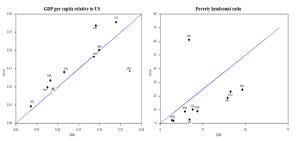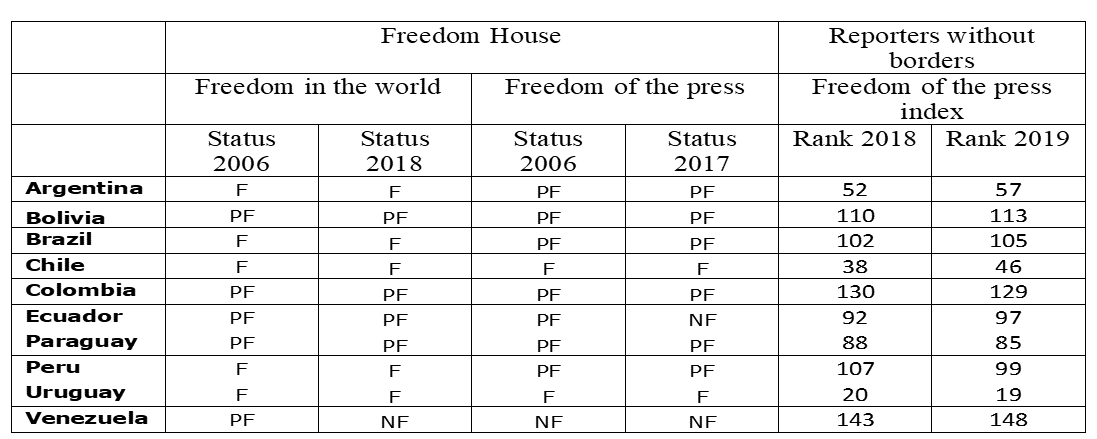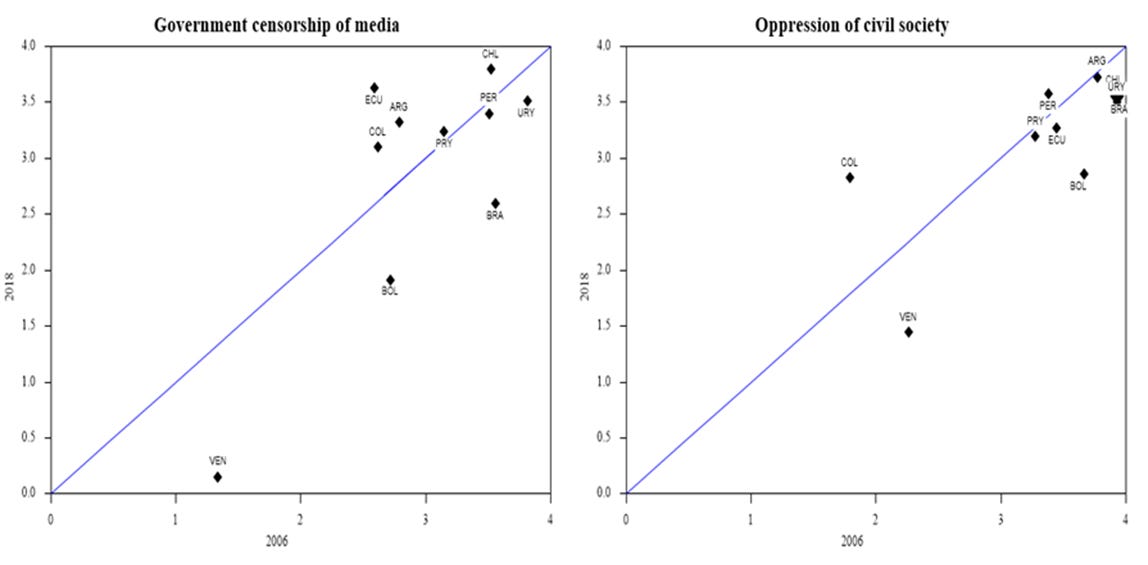Bolivia – another socialist president gone rogue.
Spoiler: It wasn’t a coup. Morales’s manipulation of the vote-counting in the Presidential election turned people against him. This was his last, of many, attacks on democracy in Bolivia. Since 2006, Morales has concentrated power, placed lackeys in the Constitution court, limited the independence the judiciary, attacked the media and oppressed civil society organisations. But Morales shall have credits for improving the lives of many Bolivians. Since he became president in 2006, extreme poverty has been halved, inequality has decreased and GDP per capita has on average grown by some 3.2% per year. At the same time has life expectancy increased by five years and neonatal mortality decreased by almost 50%.
The reality is not black and white even if one sometimes gets that impression from reading the news. The opponents to Morales are no angels and I would not accept an invitation from the interim president who abuses her interim presidential powers to the extent that security forces' killings of pro-Morales demonstrators can go unpunished. The security forces’ killings and detentions of Morales supporters are of course unacceptable. If she doesn’t keep her promises of new and fair elections, sanctions should be imposed.
The Internet is full of conflicting stories of what has happened. Using the Internet to find out if there's a coup or not can be exhausing and even daunting. In case you want to try, here are some articles about this. And there are more in the "Read more" section at the end of this post. And plenty more if you search yourself which you probably should do instead of trusting me.
I myself find it easier to assess an event like this if I can also corroborate parts of it with some data. Some articles provide a background to the events in Bolivia. And background desciptions of economic, political and social developments can be analysed and checked with publicly available data. This data not only allows for assessing Morales but also lends itself to comparing economic, social and political developments for countries over time.
Morales improved living standards for the population, poverty rates declined...
In this post I will mainly use data from the World Bank and the Varieties of Democracy project databases. The World Bank is well-known. Varieties of Democracy is a project run by the Department of Political Science at the University of Gothenburg. The project aims to conceptualise and measure democracy. More information is available on the web site.
Evo Morales entered his Presidential office in 2006 at a time when commodity prices were increasing. Government policies and revenues from the re-nationalised hydrocarbons industry paid for heavy investments and urban development programmes which led to increasing GDP per capita but also to reduced poverty, c.f. Figure 1.
Figure 1. GDP per capita and poverty in South America 2006 and 2018.
Source: World Bank Database, WDI indicators. Note: GDP per capita is measured in constant 2010 US$. Poverty is measured as the percentage of the population living on less than $5.50 a day at 2011 international prices.
Bolivia is not the only country where living standards have increased, and poverty been reduced. This has been achieved in almost all countries in South America except for Venezuela where socialist policies have created disasters.
Since 2006, Morales’s government has carried out several successful infrastructure projects and social programmes which have contributed significantly to not only increasing average incomes and reducing poverty rates but also to improving conditions for especially the indigenous population giving them more opportunities.
...and life expectancy increased...
Other successful outcomes of Morales’ policies are increased life expectancy and decreased neonatal mortality rates. The improvements are larger than in the other South American countries even though Bolivia falls behind the other countries in these respects, cf. Figure 2.
Figure 2. Life expectancy and neonatal mortality rates in South America 2006 and 2018.
Source: World Bank Database, WDI indicators. Note: Life expectancy is measured in years.
...but his achievements in terms of civil rights and rule of law aren't anything to brag about...
While there has been some progress in economic conditions for Bolivians, other South American countries have managed better. Let’s see if that applies also to politics. The Varieties of Democracy present a variable called Liberal Democracy Index. This presents a good summary of a country’s constitutionally protected civil liberties, the strength of rule of law, the independence of the judiciary, effective checks and balances and constraints on the government. It also takes the quality of elections into account. The index therefore constitutes a good starting point for looking into the developments of the civil rights of the Bolivians during Morales. It turns out that, as in other South American countries, the situation has deteriorated during Morales’s presidency, c.f. Figure 3.
Figure 3. Liberal Democracy Index 2006 and 2018 for South American countries.
Source: https://www.v-dem.net/en/
The situation in Bolivia is similar to Colombia, Ecuador and Paraguay but far better than the disaster Venezuela. The poor conditions in Bolivia are confirmed by other sources. Freedom House and Reporters without Borders document regularly the conditions for civil rights in different countries. Bolivia is still categorised as partly free by Freedom House and the press is restricted also according to Reporters without Borders, c.f. Table 1.
Table 1. Freedom in South America.
Source: Freedom House, https://freedomhouse.org/report/freedom-world/freedom-world-2018 and https://freedomhouse.org/report/freedom-press/freedom-press-2017 Reporters without borders, https://rsf.org/en/2019-world-press-freedom-index-cycle-fear
Countries with weak conditions for civil rights and constraints on governments abilities to exercise control over its citizens, organisations and media, are often characterised by high levels of Corruption and weaknesses in Rule of Law. This is true for most South American counties with the exceptions of Chile and Uruguay. And according to the World Bank’s assessments, conditions have become worse in Bolivia since Morales first was elected as president, c.f. Figure 4.
Figure 4. Control of corruption and Rule of Law in South America 2006 and 2018.
Source: World Bank. https://databank.worldbank.org/source/worldwide-governance-indicators. Note: WGI indicators range from -2.5 to 2.5.
...and he cheated in the election...
Poor institutions make it easier to cheat in elections. Thought CEPR, the American not the British CEPR, claimed that the OAS hadn’t produced any statistics or other proofs supporting the vote-counting fraud. Their assessment was premature or biased to put it mildly. Morales’s vote-counting fraud in October was not the first time he tried to manipulate campaigns, the judiciary, the media or the elections themselves in order to remain in power. The OAS audit report found irregularities in many respects:
"The manipulations of the I.T. system are of such magnitude that they should be investigated in depth by the Bolivian State in order to get to the bottom of them and determine who is responsible for such a serious situation.
The existence of physically altered tally sheets and forged signatures also undermines the integrity of the official count.
Of the 176 tally sheets in the sample that had been counted in Argentina, 38.07% were inconsistent with the number of citizens casting a vote. That is to say, the tally sheets showed a higher number of votes than voters on the voter registration lists.
Taking statistical projections into account, it is possible that candidate Morales came in first and candidate Mesa second. However, it is statistically unlikely that Morales obtained the 10% difference needed to avoid a second round.”
...which became the final straw after years of abuse of power...
And the OAS has made other remarks over the years. Its staff have criticised unequal access of political parties to private donations and use of state offices and resources by the governing parties. Other problems refer to access to media, despite laws obliging state media to grant free and equal access to all political parties during electoral processes.
During Morales, attempts have also been made to limit the independence of the judiciary. This is traditionally the weakest branch of the Bolivian government and its independence continues to be restricted. The judges of the high court have sometimes tried to demonstrate independence by resisting oppressive laws from the government such as the Autonomy Law that allowed for suspending elected officials on the basis of a formal accusation. Over the last years, however, several elected judges have faced charges in parliament and three out of even judges of the Constitutional Court have been removed from office.
As pointed out above, Morales was not the first to tamper with the judiciary’s independence. During his presidency, attempts were also made initially to improve the situation as documented by Human Rights Watch. Unfortunately, his crave for power put an end to that and led him to interfere again:
“The government has sought to reform the Bolivian justice system, which has been plagued by corruption, delays, and political interference for years. While reforms are certainly called for, current efforts pose a serious risk to judicial independence in the country.”
The deteriorations in the freedom and fairness of elections and high court independence are illustrated below, c.f. Figure 5.
Figure 5. Clean elections index and high court independence in South America 2006 and 2018.
Source: https://www.v-dem.net/en/ Note: TheClean elections index is an assessment of to what extent elections are free and fair. It takes into account the existence of registration fraud, systematic irregularities, government intimidation of the opposition, vote buying and election violence. The High court independence indicator aims gauge whether rulings are independent of the government wishes and merely reflect the letters of the laws.
As illustrated by the right panel above, especially the high court's independence has been undermined by Morales. Here’s some flesh on the bones describing how Morales used the administration’s resources to his own ends and made sure that loyalists occupied important posts in courts and electoral tribunals.
As indicated in Table 1 above, the media is restricted in Bolivia. The latest assessment of Reporters without Borders state that:
“Often at the centre of tension between supporters and opponents of Evo Morales, Bolivia’s president since 2006, the media are advised to refrain from any negative comments about the president and his government. Journalists regarded as overly troublesome are subjected to judicial harassment. Under supreme decree 181 of 2009, journalists who “lie,” “play party politics” or “insult” the government may be denied income from state advertising.”
And further:
“Journalists regarded as troublesome are subjected to judicial harassment. In September 2018, President Morales said he wanted a “Ley de la Mentira” ("Law against Lying") with criminal penalties for politicians and media outlets found guilty of disseminating “false” information. His announcement alarmed journalists, who saw that it could be used to censor criticism of the government. Combined with arbitrary arrests and a high level of impunity for violence against journalists, this has helped to foster a climate of self-censorship throughout the country.”
...Including attacks on media and Civil Society Organisations...
“Also, the government regularly attacks and intimidates civic groups that it perceives as oppositional. In 2013, new regulations for NGOs were adopted that have received criticism from international human rights organizations because they allow for the dissolution of NGOs, for instance, when they act against their declared aims. Civil society organizations also lament complex registration processes. In 2015, 38 organizations were declared “irregular” (but not dissolved) by the Ministry of Autonomy because they had failed to reregister under the new regulations.“
Such attacks on the media and the civil society don’t go unnoticed. Only Venezuela has a more depressing situation, c.f. Figure 6.
Figure 6. Government censorship of the media and oppression of civil society in South American countries 2006 and 2018.
Source: https://www.v-dem.net/en/ Note: TheGovernment censorship of media is an assessment government attempts to direct and indirect censor the media. It takes into account politically motivated awarding of broadcast frequencies, withdrawal of financial support, influencing printing, distribution, advertising and more affecting media’s conditions. The Oppression of civil society indicator aims to gauge governments attempts to oppress civil society organisations. It includes arrests, trials and imprisonments of participants in CSOs.
Having stumbled through lots of articles and done some number crunching I find that 1) the economic conditions for the population improved during Morales, 2) that he abused the constitution, put loyalists in the courts, attacked the media and CSOs in order to remain at power, 3) cheated at the election in October 4) his fall wasn't a coup but 5) security forces' attacks on Morales's supporters must be stopped and free elections must be organised under monitoring of international organisations. In case you're interested, there are some suggested reading below.
Read more:
Caracas Chronicles 11 November 2019. Evo Morales resigns. https://www.caracaschronicles.com/2019/11/11/evo-morales-resigns/
Center for Economic Policy Research, (2019). What Happened in Bolivia’s 2019 Vote Count? The Role of the OAS Electoral Observation Mission. http://cepr.net/publications/reports/bolivia-elections-2019-11
Center for Economic Policy Research, (2019). Bolivia’s economic transformation: macroeconomic policies, institutional changes and results. http://cepr.net/publications/reports/bolivia-s-economic-transformation-macroeconomic-policies-institutional-changes-and-results
Democracy Now, 14 November 2019. A coup? A debate on the political crisis in Bolivia that let to Evo Morales’s resignation. https://www.democracynow.org/2019/11/13/bolivia_evo_morales_coup_debate
Economist, 14 November 2019. Rainbow resignation. Evo Morales leaves Bolivia dangerously divided. https://www.economist.com/the-americas/2019/11/14/evo-morales-leaves-bolivia-dangerously-divided
Economist, 16 November 2019. Was there a coup in Bolivia? - The end of Evo Morales. https://www.economist.com/leaders/2019/11/16/was-there-a-coup-in-bolivia?fsrc=scn/tw/te/bl/ed/wasthereacoupinboliviatheendofevomorales
International Monetary Fund, (2016). Country Report 16/387. Bolivia. https://www.imf.org/en/Publications/CR/Issues/2016/12/31/Bolivia-2016-Article-IV-Consultation-Press-Release-Staff-Report-and-Statement-by-the-44479
National Catholic Reporter. Bishops organize talks in Bolivia as protests become deadly. https://www.ncronline.org/news/world/bishops-organize-talks-bolivia-protests-become-deadly
New York Times, 14 November 2019. Bolivia crisis shows the blurry line between a coup and uprising. https://www.nytimes.com/2019/11/12/world/americas/bolivia-evo-morales-coup.html
Open Democracy 14 November 2019. Bolivia on the brink of an abyss. https://www.opendemocracy.net/en/democraciaabierta/bolivia-en-la-incertidumbre-en/
Systemic Alternatives, 11 November 2019. What happened in Bolivia? Was there a coup? https://systemicalternatives.org/2019/11/11/what-happened-in-bolivia-was-there-a-coup/
Toward Freedom. Professors in La Paz Call on International Academics to Prioritize Peace, Reconciliation in Bolivia. https://towardfreedom.org/blog-blog/professors-in-la-paz-call-on-international-academics-to-prioritize-peace-reconciliation-in-bolivia/
The Guardian, 17 November 2019. Many wanted Morales out. But what happened in Bolivia was a military coup. https://www.theguardian.com/commentisfree/2019/nov/13/morales-bolivia-military-coup
World Bank, (2019). The World Bank in Bolivia. Overview. https://www.worldbank.org/en/country/bolivia/overview#1










